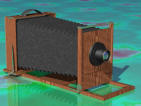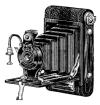How Cameras Work

To make sense out of digital photography we need to talk first about photography in general. The only important difference between a film camera and a digital camera is that the film camera captures its image on film and the digital camera captures its image on an array of electronic sensors.
A film camera momentarily opens its shutter to light, which makes chemical changes in a thin coating (emulsion) of silver bromide on top of a plastic film strip. When the film is developed and fixed, what's left behind is a pattern of silver grains.
A digital camera momentarily opens its shutter to light, which falls on a large array of very tiny charge coupled devices (CCDs) or complementary metal-oxide semiconductors (CMOS). The light generates a voltage in each of the millions of CCD or CMOS sensors and the camera very quickly scans the array and records the result on a digital memory card.
In a digital camera each sensor is called a "picture element," which gets shortened to "pixel." But if you look closely enough at the image on a film negative you'll see that the silver grains are pixels too. One difference between the two collections of pixels is that unless you have a digital camera with more than 12 million sensors in its sensor array, the film will have more pixels. Another difference is that if you're shooting color the film will have layers separated by filters. During processing, color dyes are added to the appropriate layers. In a digital camera each pixel digitally produces information that includes both brightness and color.

I wrote these essays in 2003 for a group of amateur photographers in a retirement community. Most members of the group were thoroughly familiar with the practice of photography but were more than a little put off by the idea of digital photography, which was just beginning to get under way in a serious manner.
I review the essays about twice a year and make changes as needed, so when you read an essay it may not be quite up to date. If you find errors I'd welcome an email.
Digital photograhic equipment and post-processing software have expanded exponentially since 2001, and it's becoming more and more difficult to keep up with it. I've finally replaced my wonderful Nikon D750 with a D850, though I continue to use a D750 for portraiture.. I still use my Olympus Pen-F for street shooting. Love it. Feels a lot like my good old, long-gone Leica M4.